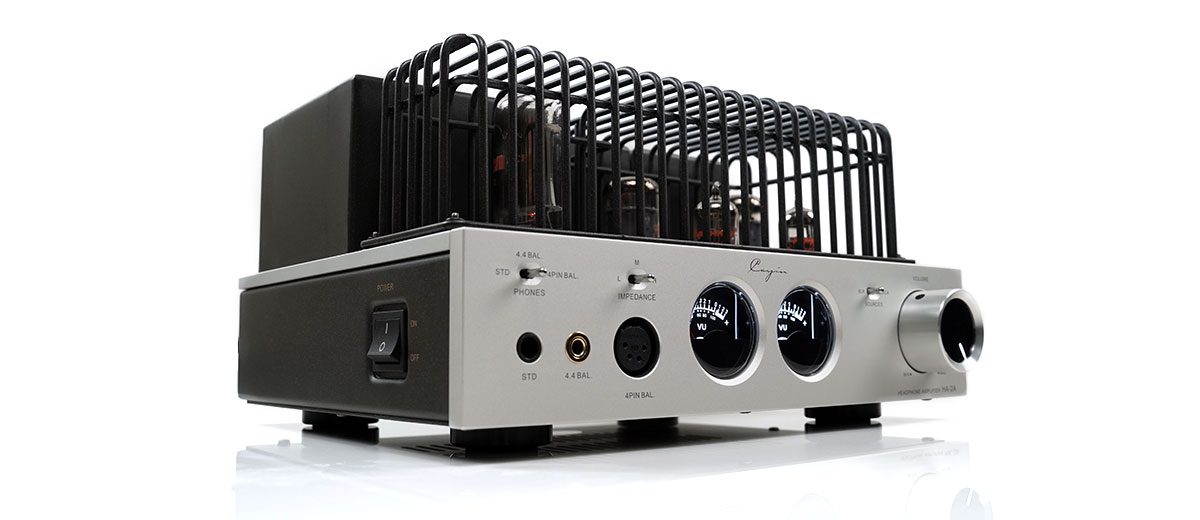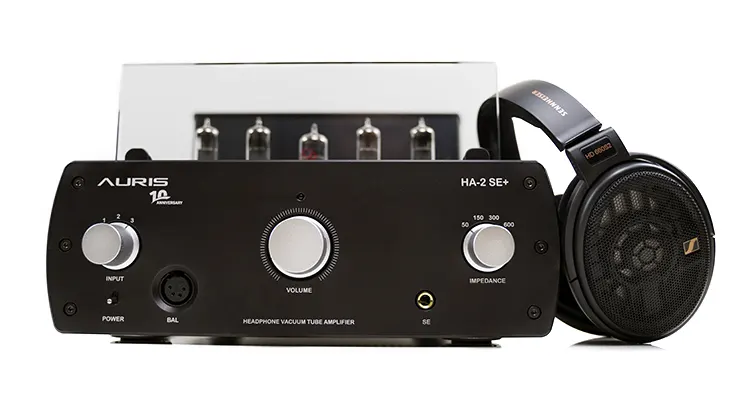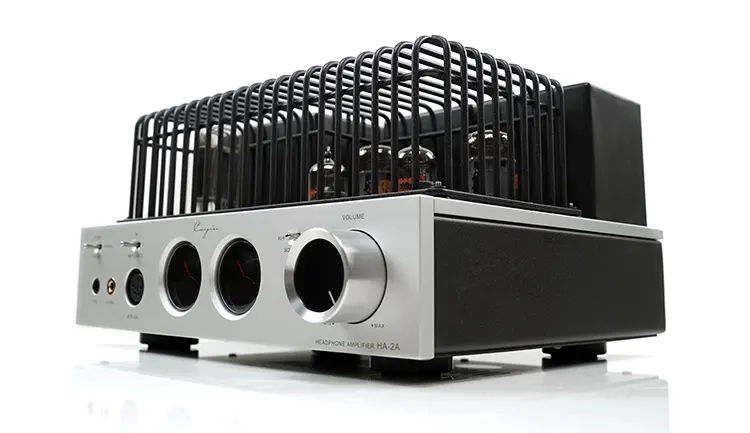Selected Comparisons
The following impressions of the Cayin HA-2A were created using a mix of the ZMF Headphones Atrium, iBasso SR3, and the Audeze MM-500 headphones with the Cayin Mini-CD MK2 as the main source and transport.
Auris Audio HA-2SE+
The Auris Audio HA-2SE+ was launched in 2023 as the successor to the HA-2SF and was one of our winners in the end-of-year Top Gear Awards. It has since received a price reduction and now matches the HA-2A SRP.
Technical
Like the HA-2A, the HA-2SE+ is a single-ended Class A amplifier though the tube implementation means it is classed as a SETA amplifier rather than Ultralinear. Unlike the HA-2A, the HA-2SE+ also has a pre-amp capability powered by a manually wound transformer on a double C core power supply.
Though both are NOS tube designs, the precise tube configuration is quite different. Auris has selected four 7-pin EI EL95 or PL95 pentode power NOS tubes and a single medium gain double triode ECC81 input tube.
Since you can use either EL or PL versions of these pentode power NOS tubes there is a switch at the back allowing you to change modes accordingly.
Probably the most significant difference in their amplification output for PO is the continuous 1W rating by design for the HA-2SE+. Regardless of output connection or impedance value, you will get a 1W supply to your headphones of choice.
The HA-2A takes a different route with a tailored output level to combat the potential for noise and a stronger focus on differing head gear types such as low-impedance headphones or IEMs.
That means its 1W PO output rating is a maximum based on its high impedance balanced output performance but can drop down to 200mW on its 4.4mm balanced output which is more useful for sensitive IEMs.
Design
The HA-2SE+ is by far the bigger of the two amplifiers and is targeted more as the centerpiece of a system. The HA-2A’s compact form factor is better suited to headphone users only with smaller spaces.
Not that the HA-2A is a featherweight amplifier. In fact, it is the heavier of the two units 10kg compared to 9.5kg so it still needs a sturdy rack shelf or desk to sit on similar to the HA-2SE+.
I prefer the more refined aesthetics of the HA-2A over the Auris design. The previous Auris amps were wood panel-based and looked more stylish whereas the HA-2SE+ black aluminum is more industrial with less of a classic HiFi allure to its shape and finishing.
The HA-2A’s elegant two-tone black and silver is more consistent with Cayin’s in-house design language for its desktop 888+2 series and much of the machining and finishing can be seen in its older units so the design process is quite stable.
That being said, I do prefer the clear labeling on the Auris amplifier. It is quite legible for my tired eyes whereas the HA-2A is a little more faded meaning you have to squint a little to read the labels in poor lighting.
Both amps have impedance selectors though the Auris is a 4-stage whereas the HA-2A’s triple stage covers a wider set of impedance values. The Auris is missing a 4.4mm PO but can accept 3 source inputs on the rear panel rather than 2 with a selector dial on the front panel to choose between them.
Performance
I tested two headphones with both amplifiers; the higher impedance SR3 and the low impedance planar MM-500. Settings on each amp were adjusted accordingly to match the 150Ω SR3 and the 18Ω of the MM-500.
For personal preference, the SR3 was a clear winner with the Cayin whereas the MM-500 sounded more ‘correct’ with the Auris. Let me explain why, and some of this is down to simply how I like each headphone to sound.
The Cayin is a richer-sounding amplifier with a denser warmer tonal coloration from top to bottom characterized by a more flamboyant level of bloom in the lows and vocal presence.
The Auris is a smooth and sweet-sounding tube amplifier with a little more articulation in the highs. It has a comparatively more neutral imaging experience with less weight and bloom on the lows and a set of mids that is clear and airy but not immediate.
Of the two, the HA-2SE+ is a little wider and taller on the staging but shallower and tighter on the lows. Whereas the HA-2SE is more immersive, stretching the stage more aggressively from the stronger vocal at the fore to the nuance spatial cue behind.
That improved depth and richness through the mids gels beautifully with the expanse and clarity of the SR3 soundstage whilst preventing the highs from bearing down harshly. The longer levels of decay are an asset to the spaciousness of the SR3 soundstage producing a very euphonic and atmospheric performance
However, the MM-500 HA-2A pairing sounded a bit too rounded and walled in with the warmer bass and vocal bloom diminishing the perception of speed and headroom. The slightly lighter tone and shorter decay of the HA-2SE+ create the necessary energy, height, and space for the more intimate MM-500 to shine.
Monoprice Monolith Liquid Platinum Amplifier
The Monoprice Monolith Liquid Platinum was designed by Alex Cavalli and is a balanced version of the highly-regarded Liquid Crimson amplifier. It was reviewed by me back in late 2019.
Technical
The Liquid Platinum is also a desktop amplifier and though it uses tubes it’s an embedded tube/hybrid amplifier, (DC coupled in to out, no coupling caps) as opposed to the HA-2A’s Ultralinear implementation.
That means it has a dual Electro Harmonix 6922 tube pre-amp section and a balanced/SE solid-state output section. Whereas the HA-2A is all tubes with a point-to-point welded pure Class A transformer-coupled single-ended design and no pre-out or pre-amping capability.
Generally, hybrids also mean a low output impedance value by default whereas classic vacuum designs output at a much higher level. However, the HA-2A has been set up by Cayin to accommodate much lower impedance values with its impedance selector system so it’s not a simplistic difference in 2024.
The Liquid Platinum does not offer a 4.4mm output but its 4-pin XLR PO output is a balanced-design output with a higher power rating of up to 6.62 watts into a 32Ω load dropping to 0.91 watts for 300Ω loads.
The Cavalli design SE output power curve peaks a little higher at 4.21 watts into 56Ω as opposed to 1.78 watts at 32Ω dropping down to 230mW at 300Ω.
The HA-2A goes in the opposite direction with up to 1W available at 300Ω-600Ω from its 4-pin XLR and dropping slightly to 750mW SE on the same loads making it much more suitable for single-ended high-impedance headphones. To get close to that power and impedance mix, you need to go balanced with the Liquid Platinum.
Design
Courtesy of a separate switching power brick, the actual Liquid Platinum unit is a smaller design with a lower profile compared to the HA-2A.
The surface area differences on the table are not huge though, this is more about the weight and height difference with the Platinum weighing just 1.5kg compared to the transformer-laden 10kg of the HA-2A.
The aesthetics of the Platinum are closer to the modernistic industrial vibe of the Auris than the classic HiFi of the HA-2A. It has a gunmetal finish with low tube seating giving it a more discreet look. To be honest, if you are using a tube amp, I always feel you want to show it off not hide it.
Still, if you are stuck for space the Monoprice amp will take up far less of it compared to the HA-2A.
My main criticism of the Liquid Platinum design is the lack of tube guards for its dual 6922s on the top plate. They are very prone to slight movement if you touch them even slightly and it might be possible over time for the pins to bend or break if hit with any force.
I also prefer the interface of the HA-2A. The language and labeling are more intuitive with the platinum relying on abbreviations or icons that are not immediately obvious. One such example is the ‘I’ button on the far right of the Platinum front panel which selects a balanced or single-ended input.
PO outputs are also more comprehensive on the HA-2A with provision for an additional 4.4mm connection whereas the Platinum is 6.35mm and 4-pin XLR only. Both are similar with RCA and XLR 3-pin inputs on the rear panel.
Performance
While the Liquid Platinum is arguably a smooth and musical pairing, it does differentiate from the HA-2A with some solid-state traits and a different tonal emphasis with our pairings.
The Monolith Liquid Platinum is more neutral in its tonal character with a tauter low-end and more sub-bass bias. The mid-to-upper bass response is flatter with more physicality in the upper-mids and lower treble timbre.
Vocal weight is also more neutral with higher pitching percussion strikes cleaner and more noticeable sounding. The combined traits produce a soundstage that is perhaps taller and deeper but not as emphasized or as forward through the mids compared to the HA-2A.
This is a presentation I prefer with relaxed-sounding headphones such as the ZMF Headphones Atrium. The solid-state ‘energy’ and stronger treble add some necessary contrast into the Atrium’s smoother midrange coloration.
The HA-2A has a more obvious classic tube presentation with its thicker, richer instrumental timbre and a noticeably longer note decay.
Its sub-bass performance is more subdued but compensates with a fuller-sounding mid-to-upper bass response. It also has a more immediate and euphonic-sounding vocal performance and improved staging width over the Liquid Platinum.
These are qualities that I find to pair well with the excellent space and midrange clarity from the higher impedance SR3.
The HA-2A also has an advantage with IEM pairings. Using the sensitive Vision Ears VE10 pairing the 4.4mm output was quite clean and noise-free with an impressive black background with a small amount of channel bias at very low volumes.
The Liquid Platinum’s lower-powered SE output was quite noisy with the VE10 with some EMI interference being picked up and a much stronger lower volume imbalance. The volume control is also less refined with that high amount of available power.
My Verdict
The Cayin HA-2A is a very endearing and well-equipped compact tube amplifier for space-conscious audiophiles with a wide selection of headphones and IEMs.
It delivers a rich, smooth sound with a pleasing low-end dense punch and a spacious holographic sound stage best suited to natural-to-naturally tuned open-sounding headgear. It also has a pleasingly low noise level and muted tube microphonics for sensitive IEM pairings.
The additional impedance selector and the tailored output power options make it very adept in accommodating a wide range of differing loads efficiently as well as fine-tuning the technical performance of most pairings.
Drawbacks? It is not the last word in sub-bass growl or low-end tightness and despite its compact size, its 10kg weight still needs solid support underneath its feet.
Otherwise, this is a classy-looking little all-rounder headphone tube amplifier and a great example of how tickle-down flagship technology can transform into something that can perform at the more affordable end of the scale.
Cayin HA-2A Technical Specifications
- ECF82/6U8 Input, 17BF11 Power Tubes, 17AX4GT Rectifier
- Output power <1,000 mW per channel
- SNR <101dB
- THD <0.2%
- Impedance-matched headphone output
- XLR, 1/4″ and 4.4 out, XLR and RCA in
- Point-to-point wielding with premium wire
- Dimensions: 270 x 215 x 143 mm
- Weight: 10kg




